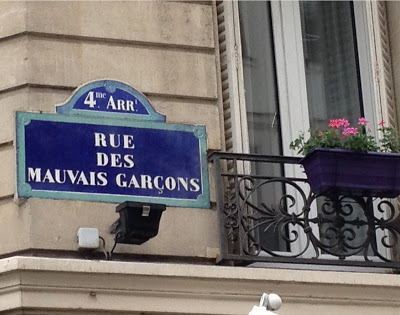Kristin Cashore's Blog, page 35
June 27, 2013
June 24, 2013
Current Work Breakdown, for Them That's Interested
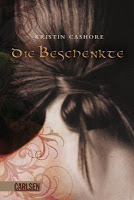 As I've mentioned recently, I'm revising a manuscript. Here's a breakdown of what this revision tends to look like on a daily basis:
As I've mentioned recently, I'm revising a manuscript. Here's a breakdown of what this revision tends to look like on a daily basis:For one hour or so, I reread and ponder the responses of my early readers and my own notes (as I blogged about recently).For maybe two or three hours, I look back over the revising I did yesterday and all the days before, getting a second look at my revisions and changing things here and there.For maybe an hour or an hour and a half, I push forward in the book, maybe revising one more chapter.I find I'm working anywhere from two to seven hours in a session (with a lot of breaks), depending on what else I'm doing that day and how quickly I get mentally drained. I never sit down intending to work seven hours – generally that's too much, too draining – but occasionally I'll look up and be startled to see how much time has passed. (This happens more often in summer than winter – the sun sets so late!)
Sometimes I only skim the responses and notes. Sometimes I never get to the third step, where I'm pushing forward in the book. It all depends on what's happening that day. If I have a sudden revelation about why one of my characters has been behaving the way she's been behaving, for example, I may spend the entire session starting again from the beginning and revising with fresh eyes.
Also, about those breaks I take – they involve a lot of resting my writing mind while listening to music. Especially, though not exclusively, a wide variety of cello music, because cello is relevant to the manuscript I'm revising. I'll probably write more about that at some point.
One more thing about breaks. It can be very hard, on a daily basis, to get started working. You can be overwhelmed with a feeling of "I just don't wanna" and find yourself slow to begin… SO, it can feel really lovely on days when for whatever reason you find yourself eager to get working. However, if I notice that it's anxiety that's making me eager to get working – if the writing has somehow convinced me that there's some part of the novel I should feel anxious about, and should obsess over, RIGHT NOW, this needs to be fixed or something terrible will happen – I've come to realize that this means it's time for a day off. I spend that day consciously rejecting thought about the writing, resting, and doing things to care for the anxiety instead. The next day, I am generally able to return to the manuscript refreshed and with unanxious purpose.
So. This isn't always how I revise, but it's fairly typical for the second or third major revision of a manuscript. As I near any climaxes in the plot and especially as I near the end, my pace will pick up dramatically, and I will probably work longer hours. That just tends to be what the book asks of me.
There is no right or wrong way to do this, no right or wrong way to divide your own time, and you may not have seven free hours (or even two!). That's okay. Trust yourself, and trust the book to tell you what it needs. It's going to be hard and it might never feel quite right. That doesn't mean it's wrong. :)
Moving on: this revision isn't the only creative work I'm doing. Here's a rough breakdown of my overall work:
Maybe 85% of my work is on this revision.Maybe 14.5% of my work goes to planning the next book I intend to write.Maybe 0.5% of my work goes to a third book, the first draft of which I recently completed and which I'm currently taking time away from. I try not to think about it at all, because time away is critically important, but occasionally an idea for how to improve the book will present itself, at which point, I'll take down a note.I didn't plan for this 85/14.5/0.5 split; I let it happen, observed it happening, decided it was okay, and continued to let it happen. If some part of it stops working, I'm sure the percentages will shift, and I'll reassess.
As far as that next book goes – here's a rough breakdown of what book-planning involves at the moment:
Maybe 90% of the time is spent reading (probably 80% fiction and 20% nonfiction) and watching things (probably 50% TV and movie dramas, 50% documentaries). With the exception of the nonfiction reading, which is directly about topics relevant to the book, most of what I'm reading or watching would seem, to the casual observer, to have absolutely nothing to do with the book I'm planning. For example, I just watched a Swedish documentary about a world-class ballerina (Dansaran – loved it) and there is no dancing in the book I'm planning. I'm reading Ann Patchett's Bel Canto, which is about a modern-day hostage situation in an unnamed Central or South American country (and also about opera), and the book I'm planning is a fantasy, not modern-day, that I don't think has anything to do with hostages or opera. I can't explain how I choose the things I'm reading and watching. I'm looking for something, something about people and life, something about the way other people navigate their lives or the way other artists record people navigating their lives. Slowly (SO slowly!), I'm finding what I'm looking for. The book-planning process involves a lot of indirect searching for indirect things, and a lot of trusting that if I am thoughtful and attentive about my input, I will make accidental discoveries. In the meantime, it – writing, watching, and letting things grow in a non-pressurey way – is one of the most pleasurable things about being a writer.Maybe 5% of the time is spent sitting down with my notes, trying to hammer out the plot, and daydreaming. When the majority of my work time eventually shifts to this book (rather than the revision I'm working on), the majority of my planning time will shift to this activity – wracking my brain, hammering out the plot, and also letting my brain wander. I will still be watching things and reading, but these direct activities will take up most of my time.Maybe 5% of the time is spent talking to friends about the project. All of these breakdowns omit the other part of the process, namely, that whenever I'm awake, I'm keeping myself open to the arrival of an idea.
And that's what's going on.
 My workspace. (At home in Cambridge, MA. I'm back from Paris. I loved Paris! I also love home.)
My workspace. (At home in Cambridge, MA. I'm back from Paris. I loved Paris! I also love home.) Happy-making details: my clock.
Happy-making details: my clock.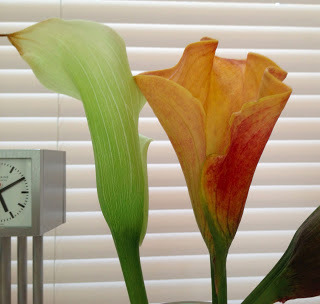 Lilies increase productivity. It's been proven.
Lilies increase productivity. It's been proven. Ear plugs and pink duck eraser: v. important.
Ear plugs and pink duck eraser: v. important.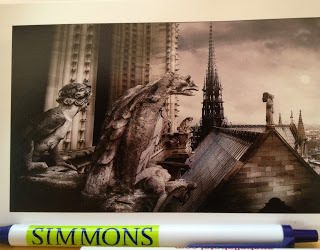 Postcard of gargoyles on Notre Dame: stirs the imagination.
Postcard of gargoyles on Notre Dame: stirs the imagination.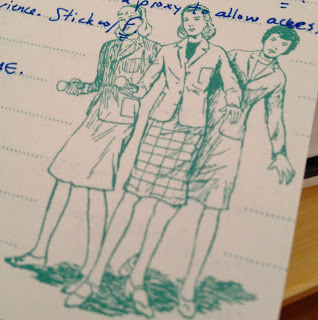 Nancy Drew-themed notebook: for jotting down clues.
Nancy Drew-themed notebook: for jotting down clues.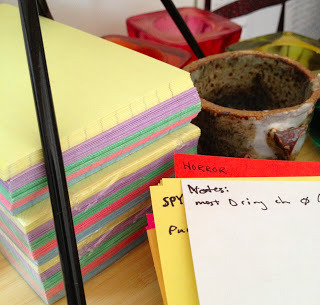 Index cards: a writer can never have too many.
Index cards: a writer can never have too many.
Published on June 24, 2013 07:01
June 22, 2013
Another Paris Picture Roundup
 If you're a gargoyle, Sacre Coeur is probably a nice thing to be a gargoyle on,
If you're a gargoyle, Sacre Coeur is probably a nice thing to be a gargoyle on,and Montmartre a nice part of Paris to look out over…
 Outside the Musée Rodin, people stick their entrance stickers onto poles –
Outside the Musée Rodin, people stick their entrance stickers onto poles –a spontaneous public arts project :)
 On one of the footbridges over the Seine – I think it's the Pont des Arts? – people attach locks to the fence
On one of the footbridges over the Seine – I think it's the Pont des Arts? – people attach locks to the fenceto symbolize their romantic relationships. ... Normally I'm all for these things – note the Rodin stickers above
and the graffiti – but am I the only person who doesn't get a romantic feeling from a lock exactly?
 Marie took this :). It was so sunny that I reached into my bag at one point
Marie took this :). It was so sunny that I reached into my bag at one pointto get my sunglasses – not realizing I was already wearing my sunglasses.
 Marie and me, self-portrait, in front of one of the big clock windows at the Orsay.
Marie and me, self-portrait, in front of one of the big clock windows at the Orsay. All of the shoes in this picture are made of chocolate.
All of the shoes in this picture are made of chocolate. All of the dogs in this picture are large.
All of the dogs in this picture are large. Free samples on the windowsill outside this perfume store in the Marais.
Free samples on the windowsill outside this perfume store in the Marais. Passage Jouffroy.
Passage Jouffroy. Entrance.
Entrance.
Published on June 22, 2013 10:20
June 19, 2013
Paris: Graffiti
 At the flea markets de la porte de Clignancourt.
At the flea markets de la porte de Clignancourt.
 Outside the markets.
Outside the markets.

 Skeleton grate. Somewhere in the 7th, I think....
Skeleton grate. Somewhere in the 7th, I think.... On Quai de Jemmapes.
On Quai de Jemmapes. I think this was in Le Marais...
I think this was in Le Marais... And this near Place de la Bastille.
And this near Place de la Bastille. This too.
This too.
Published on June 19, 2013 12:55
June 17, 2013
Paris: Clocks. (And Snoods.)
 The Musée d'Orsay, which contains the world's largest collection of impressionist and
The Musée d'Orsay, which contains the world's largest collection of impressionist andpost-impressionist paintings, is in what used to be the Gare d'Orsay -- a Beaux-Arts train station
built at the turn of the 20th century. A number of the windows, like this one in the café, are clocks
(to show the time to the outside world).
 Here's another one in an anteroom adjacent to one of the galleries.
Here's another one in an anteroom adjacent to one of the galleries. It's kinda amazing to see a view of Paris through an enormous clock.
It's kinda amazing to see a view of Paris through an enormous clock. Sacré-Coeur in Montmartre through a clock.
Sacré-Coeur in Montmartre through a clock. One more clock in the Musée d'Orsay.
One more clock in the Musée d'Orsay. Here's a clock on Boulevard du Palais on the Île de la Cité. Paris is divided in two by the Seine,
Here's a clock on Boulevard du Palais on the Île de la Cité. Paris is divided in two by the Seine,and the Île de la Cité is a little island in the middle of the river. It's where Notre Dame is, and also
the Prefecture de Police, the Palais de Justice (which includes the Sainte Chapelle),
a hospital, and the Tribunal de Commerce. And the flower markets, and this clock.
 This clock is on the face of the Church of Saint Paul-Saint Louis on Rue Saint-Antoine in the Marais district.
This clock is on the face of the Church of Saint Paul-Saint Louis on Rue Saint-Antoine in the Marais district. These next few were at the flea markets de la porte de Clignancourt.
These next few were at the flea markets de la porte de Clignancourt.

 In the Passage Jouffroy, 9th arrondissement.
In the Passage Jouffroy, 9th arrondissement.(Jouffroy is one of the hidden covered passageways in Paris.)
 Institut de France. Location of the Bobliothèque Mazarine.
Institut de France. Location of the Bobliothèque Mazarine. One of two clocks on Saint-Ambroise, Boulevard Voltaire...
One of two clocks on Saint-Ambroise, Boulevard Voltaire... where both clocks are showing the wrong time --
where both clocks are showing the wrong time -- and the towers are wearing snoods!
 Parisian towers are so snoody.
Parisian towers are so snoody.
Published on June 17, 2013 07:55
June 13, 2013
Bots High, Émile Zola, and yes, more 2CELLOS
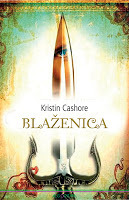 I adore
Bots High
, which is a documentary about high school students in Miami building combat robots and competing in a national robotics competition. Incidentally, many, many of the robot engineers are girls. That's only one of the reasons to watch -- I love these kids, love their smarts, creativity, procrastination, anxiety, heart, the ways they take care of each other.
I adore
Bots High
, which is a documentary about high school students in Miami building combat robots and competing in a national robotics competition. Incidentally, many, many of the robot engineers are girls. That's only one of the reasons to watch -- I love these kids, love their smarts, creativity, procrastination, anxiety, heart, the ways they take care of each other.Wanting to read a novel that takes in Paris while I'm in Paris, I settled on Émile Zola's Au Bonheur des Dames ("The Ladies' Delight"), translated by Robin Buss. First published in 1883, it's about a fictional department store in the era when department stores were new to Paris; the store's brilliant, attractive, and dissolute owner, Octave Mouret; his staff, and in particular a strong young women of dignified purity named Denise Baudu; and all the small merchants in the neighborhood whose lives and livings are destroyed by the capitalist behemoth in their midst. It's repetitive, predictable (except when it's not!), preachy (but interestingly ambivalent!), packed with extreme figurative language, overflowing with excessive and flowery description, and about as believable as a fairy tale (though I won't say whether of the Disney or the dark variety). I LOVE it. A French friend tells me this is pretty much the only Zola book that isn't chock-a-block with depression and despair. I wish certain other depressing, despairing writers had written one (relatively) happy, cheerful book. Can you imagine if there were one happy, cheerful Edith Wharton book, or one chipper Henry James? I love Edith Wharton, don't get me wrong, but there isn't much mirth in her house. Anyhoo. This Zola has been the perfect read for me just now.
Finally, it's been ages -- ages! -- since I've posted some favorite 2CELLOS covers. Here are two heavy metal songs wonderfully well-suited to cello, for your enjoyment and also the enjoyment of your babies. (I've been receiving reports from friends that not only do they enjoy the 2CELLOS stuff but so do their babies. Happy babies! Just one more thing to love about 2CELLOS! ^_^)
Forthwith, a cover of Racer X's "Technical Difficulties" and one of Nine Inch Nails' "Hurt." (I think NIN's Downward Spiral counts as heavy metal, but "Hurt" has a real softness and lyricism to it, and the cello accentuates this -- while the lack of lyrics automatically strips out a lot of the angst. Google the original "Hurt" if you don't know it and are interested, but note it's not safe for work -- unless your workplace is okay with Trent Reznor singing about his crown of shit.) (ETA: Here's an unplugged version of "Hurt" with Reznor on piano that is safe for work -- and also quite lovely! Though if you listen to this one, you NEED to listen to the original, just to appreciate the difference.) (Okay, I promise I'm done babbling about this now.) After that, I also embed Luka Sulic of 2CELLOS playing the theme to Schindler's List, with my parents, and listeners like them, in mind -- for those of you who might love cello, but not necessarily rock covers on cello. This theme has been overplayed, IMO, but this interpretation, truly gorgeous, lifted me out of my lethargy.
Published on June 13, 2013 10:41
June 11, 2013
Paris: Rue des Mauvais Garçons
Published on June 11, 2013 09:51
For Writers: A Quick Tip on Starting
When writing, there's a danger in depending too much on preparation. Yes, preparation is important, but you're not going to figure everything out about a writing project before you start it. Part of the point is that you figure it out while doing it. You're planning a book, and you can't figure out the solution to a certain plot puzzle, or how one of your characters feels about something, or even what someone's name is? Maybe that means it's time to start writing. You're not completely ready? As with most things in life, if you wait until you're completely ready, you'll never start. Get a new definition for "ready." Just as courage often involves being scared to death, readiness often involves accepting that you don't really know what's going to happen. :)
 I also advise tea and chocolate.
I also advise tea and chocolate.
 I also advise tea and chocolate.
I also advise tea and chocolate.
Published on June 11, 2013 02:47
Three Writers in Paris
Published on June 11, 2013 02:45
June 10, 2013
For Sendak Fans
Sendak fans, get to the google search page by the end of the day and press play on Max to see the animation in honor of what would have been Sendak's 85th birthday. Beautiful.


Published on June 10, 2013 10:24
Kristin Cashore's Blog
- Kristin Cashore's profile
- 16946 followers
Kristin Cashore isn't a Goodreads Author
(yet),
but they
do have a blog,
so here are some recent posts imported from
their feed.


